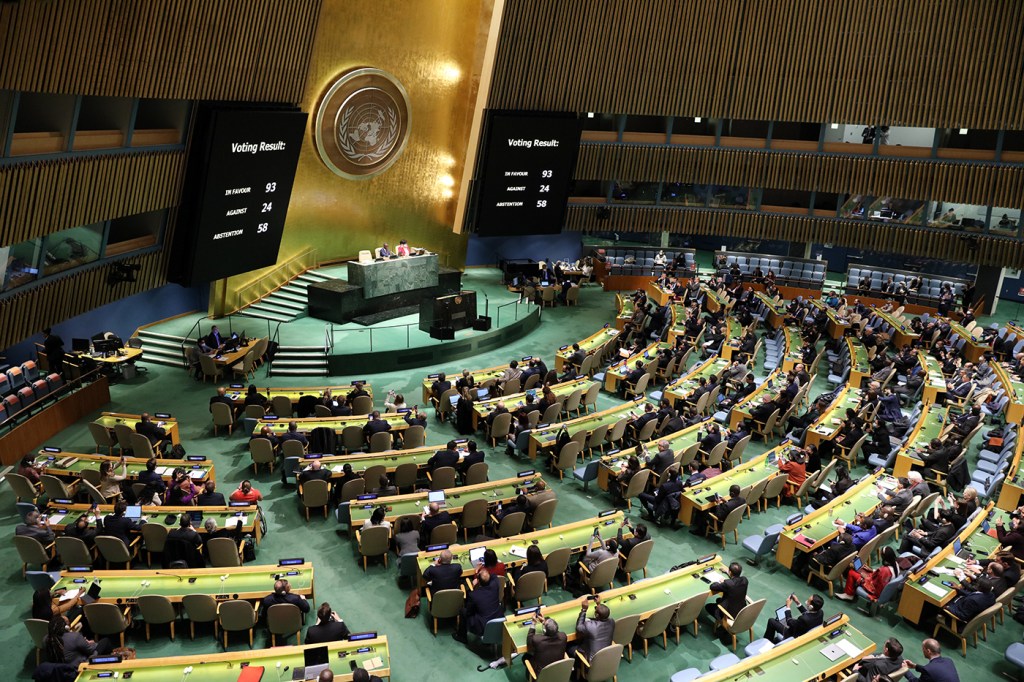The shackles of the United Nations Security Council veto, explained

This report is part of ongoing coverage of the Russia-Ukraine war. Visit our dedicated page for more on this topic.
In an impassioned address to members of the United Nations Security Council earlier this month, Ukrainian President Volodymyr Zelenskyy challenged diplomats to intervene in Russia’s invasion into the country, citing alleged atrocities committed by Russian troops throughout the war thus far. Despite the outrage of many individual members on the council to the scenes Zelenskyy depicted, the international body declined to act, bound as it is by Russia’s ability to veto any resolutions that are passed.
Is it time, as Zelenskyy argues, to reform this unilateral power?
“This is something that comes up again and again in U.N. working group sessions,” says Fiona Creed, associate teaching professor at Northeastern, who formerly served as executive director of the United Nations Association of Greater Boston. “The veto itself is one of the topics most frequently raised within the context of almost everything to do with how the Security Council works.”

The Russian Federation is one of five nations that hold such veto power on the Security Council—a group known as the “permanent five” or “P5” that also includes China, France, the United Kingdom, and the United States.
Permanent members use the veto to “defend their national interests, to uphold a tenet of their foreign policy, or, in some cases, to promote a single issue of particular importance to a state,” according to a U.N. Security Council report.
Since Feb. 16, 1946, when the Union of Soviet Social Republics (USSR) cast the first veto, it’s been used close to 300 times by members of the permanent five, most frequently by Russia (120 times) and the U.S. (82 times), according to data from the Dag Hammarskjöld Library.
In his speech to members of the U.N., Zelenskyy contended that Moscow “turns the right of veto in the U.N. Security Council into a right to kill.” Other prominent voices, including those on the opinion pages of several major news organizations, have also argued that the P5 countries’ ability to unilaterally obstruct U.N. resolutions has rendered the international organization irrelevant, and called for reform.
News@Northeastern discussed the complex issue with Creed. Her comments have been edited for brevity and clarity.
Let’s start with the basics: How does a U.N. veto work?
In practice, the UN Security Council has formal and informal debates, which lead to ‘resolutions’ or ‘decisions’—these official decrees are like the laws that are passed by U.S. Congress, with one key difference in the Security Council: All votes are not equal.
In the Security Council, the permanent five members have veto power over substantial resolutions. Under the U.N. charter, the permanent five alone hold the veto. When a member of the P5 votes against a resolution, it fundamentally ends it, even though the other 14 members might have voted yes. That a P5 member can block a resolution means it has absolutely nothing to fear from any Security Council proposal it considers unacceptable. It simply casts a vote and the matter is over. The issue of the Security Council veto has been a point of contention for many years.
Is the veto used a lot?
Most resolutions do end up passing by a majority vote or even consensus. When considered in context, the veto isn’t used all that frequently, it’s just that we tend to hear about it when it is.
Overall, Russia has been the most frequent veto user, followed by the U.S. and the U.K.
China’s use rose considerably since 2011, with the conflict in Syria accounting for most. In 2014, [when Russia annexed the Ukrainian peninsula of Crimea], the Russian Federation vetoed resolutions concerning themselves and Ukraine. And in 2017, Russia cast five vetoes, all against resolutions aimed at resolving the war in Syria and the use of chemical weapons. At that particular time, Russia claimed its motivation for veto use was that the U.N. was interfering in the national affairs of a member-state.
Is there anything the U.N. can do to isolate Russia in the meantime, while it still has this veto power?
The options are limited. The invasion of Ukraine has raised the question of whether Russia can be removed from the Security Council. At this point, the answer is no, because Russia will veto any resolution that proposes such action. Still, this may happen anyway and member states could pursue the call for removal. If a majority of the Security Council members voted to remove Russia, even when Russia vetoes it, the action itself would be symbolic and it sends a strong signal to the international community and to Russia itself.
We saw the U.N. make a similar statement when member states voted to suspend Russia from the Human Rights Council. Russia followed up with a statement stating that it was resigning from the Council. How one resigns from something they’ve already been removed from, however, is unclear to me. The privilege of the P5 having the power of veto may go against democratic principles but the U.N. is not a democracy; it’s an assembly of 193 sovereign and independent states.
For media inquiries, please contact Ed Gavaghan at e.gavaghan@northeastern.edu or 617-373-5718.





